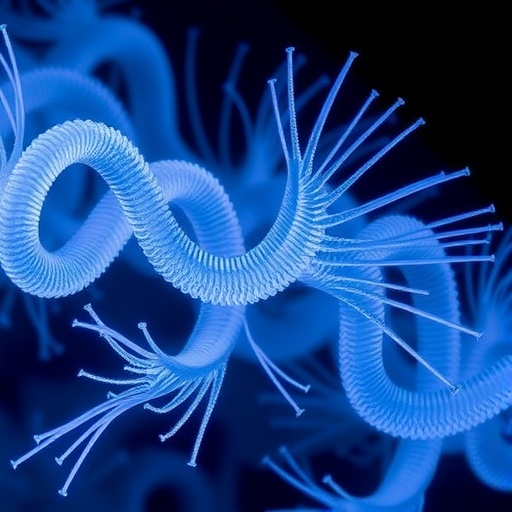In a groundbreaking study that promises to reshape our understanding of microscopic locomotion, researchers at the University of Exeter have unveiled the intricate mechanics behind how marine larvae coordinate the movement of their cilia—tiny hair-like organelles essential for propulsion. This research not only elucidates the complex choreography required for efficient swimming but also addresses longstanding debates about cellular communication and coordination within ciliary bands, which are pivotal for survival in aquatic environments.
Cilia, found ubiquitously across a broad range of organisms including humans and many marine species, serve as the primary means by which microscopic aquatic creatures navigate their fluid surroundings. In marine plankton, which form the foundational trophic levels of oceanic ecosystems, cilia are organized into bands that act as synchronized oars. These structures are vital for myriad biological functions such as locomotion, feeding, predator evasion, and strategic dispersal to optimal habitats within the water column. Understanding the physical and biological basis of how these cilia coordinate their beating patterns is thus of prime ecological and evolutionary significance.
The phenomenon of metachronal waves—sequential, orchestrated beats that propagate across arrays of cilia much like a Mexican wave at a stadium—has fascinated biologists and physicists alike. These waves maximize propulsion efficiency and prevent the mechanical interference that would arise from unsynchronized ciliary motion. Despite decades of research involving advanced microscopy and theoretical modeling, the exact mechanisms by which these waves arise and maintain coherence over thousands of motile elements remained elusive.
Exeter’s team focused on the larvae of the marine rag worm Platynereis dumerilii, a model organism prized for its spherical body plan and a ciliary band that forms a single continuous ring. This organism’s relatively simple nervous system and uniquely accessible ciliary arrangement made it ideal to probe the underlying principles governing collective cilia behavior. Employing cutting-edge whole-body high-speed imaging, the researchers captured the real-time dynamics of metachronal waves and manipulated various experimental parameters to dissect the contributions of cellular and mechanical interactions.
Surprisingly, their observations challenged the traditional view that metachronal wave coordination relies primarily on long-range signaling between cells. Contrary to anticipated models suggesting that waves propagate seamlessly across entire ciliary bands, the team discovered a striking compartmentalization of coordination. Metachronal waves are in fact emergent solely from local, short-range interactions constrained within individual epithelial cells. The wave does not traverse cellular boundaries as once assumed, but rather resets at each cell interface, revealing a highly localized mechanism.
Delving deeper, the researchers identified steric interactions—physical collisions and mechanical pushing between densely packed cilia—as the critical driver of this coordination within cells. This mechanical coupling ensures that the cilia beat in a phase-shifted sequence, generating the characteristic traveling waves that optimize fluid propulsion. This insight underscores a paradigm wherein biomechanical forces, rather than purely biochemical signaling, provide the structural basis for the emergent rhythmicity observed in multicellular ciliary arrays.
Professor Kirsty Wan, who led the investigation at Exeter’s Living Systems Institute, emphasized the profound implications of these findings. “Marine plankton are the engines of ocean life, and their ability to effectively disperse and position themselves in the water column depends critically on ciliary function,” she remarked. “Our work reveals an elegant and robust biophysical design that allows larval organisms to maintain effective swimming even under cellular damage—illustrating a remarkable evolutionary solution to ensure survival.”
Moreover, the robustness of this system is notable. Despite physical perturbations to the ciliary band, such as accidental damage or environmental stressors, the metachronal wave patterns remain intact within cellular domains, allowing the larva to continue swimming. This mechanical redundancy serves as an evolutionary advantage, enabling resilience against injury and ensuring persistent motility in dynamic, unpredictable marine habitats.
From a biophysical perspective, the study opens new avenues for understanding how local interactions can give rise to coherent global behavior in biological systems. The findings echo principles seen in other collective phenomena such as neuronal networks and cardiac tissues, where local coupling produces emergent large-scale patterns without requiring direct long-range connectivity.
Importantly, the insights gleaned from Platynereis larvae may also have translational implications. Understanding ciliary coordination at this fundamental level could inform biomedical research into human ciliary disorders, which lead to conditions like primary ciliary dyskinesia. Additionally, biomimetic engineering efforts aimed at designing synthetic micro-swimmers or fluidic devices may exploit similar steric-interaction-based coordination mechanisms to achieve optimal motility and control.
This study represents a significant leap forward in the field of cellular physiology and marine biology. By integrating advanced imaging techniques with rigorous experimental manipulation, the Exeter team has provided a definitive characterization of metachronal wave emergence, highlighting the essential role of mechanical interactions within cells. Their findings not only resolve a decades-old mystery but also enrich our understanding of collective cellular behavior in natural systems.
The research, funded by the European Research Council and Wellcome Trust, has been published in the prestigious journal Science Advances under the title “Dynamics and emergence of metachronal waves in the ciliary band of a metazoan larva.” It stands as a testament to the power of interdisciplinary collaboration and innovation in unraveling the complexities of life at microscopic scales.
As marine ecosystems face mounting pressures from climate change and pollution, insights into the fundamental biology of planktonic organisms become ever more critical. The meticulous work of Professor Wan and her colleagues provides a foundational understanding that may inform conservation strategies and ecological models, ensuring these microscopic architects of ocean health continue their vital roles for generations to come.
Subject of Research: Animals
Article Title: Dynamics and emergence of metachronal waves in the ciliary band of a metazoan larva
News Publication Date: 15-Oct-2025
Image Credits: Rebecca Poon & Kirsty Wan, University of Exeter
Keywords: Organelles, Cilia, Metachronal waves, Marine larvae, Cellular coordination, Biomechanics, Microorganisms, Locomotion, Steric interactions, Fluid dynamics




